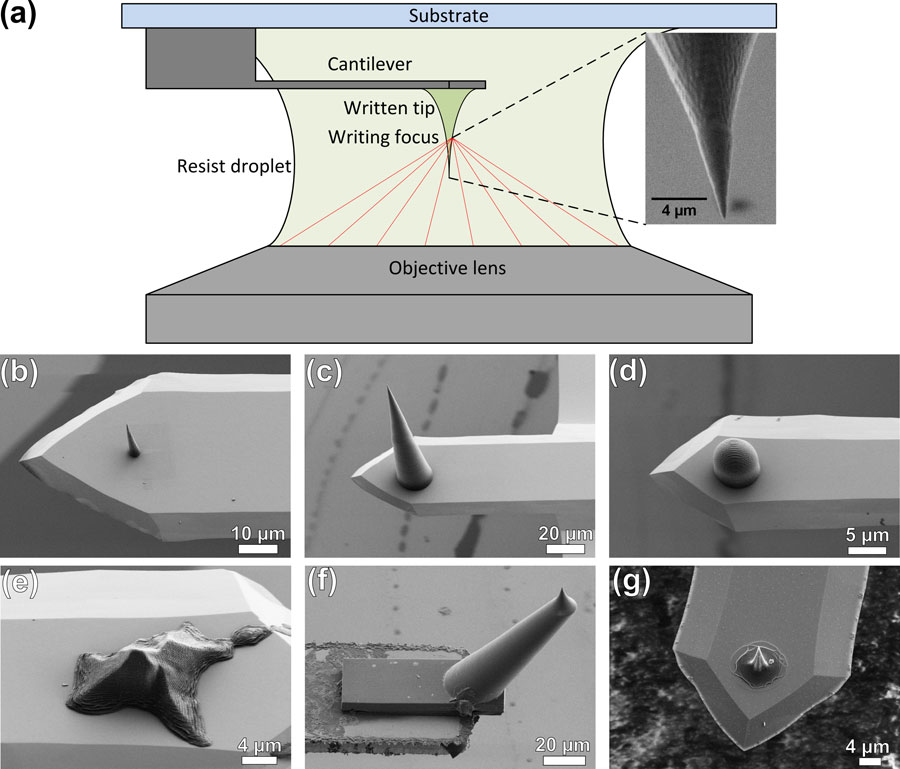A group of Karlsruhe Institute of Technology researchers in Germany report using 3-D direct laser writing based on two-photon polymerization as a tool to fabricate custom-made probes for atomic force microscopy (AFM).
From the Journal: Applied Physics Letters
WASHINGTON, D.C., August 8, 2016 — Atomic force microscopy (AFM) is a technique that allows researchers to analyze surfaces at the atomic scale, and it’s based on a surprisingly simple concept: A sharp tip on a cantilever “senses” the topography of samples.
While this technique has been successfully used for more than 30 years, and you can easily buy standard micromachined probes for experiments, standard-sized tips aren’t always exactly what you need. Researchers frequently desire tips with a unique design — a specific tip apex shape or extremely long tips that can reach the bottom of deep trenches. Preparing nonstandard tips via micromachining is possible, but it’s often expensive.
But now, a group of Karlsruhe Institute of Technology (KIT) researchers report that they have developed a method to tailor tips for specific applications via 3-D direct laser writing based on two-photon polymerization that will be appearing on the cover this week in Applied Physics Letters, from AIP Publishing.
Two-photon polymerization is a 3-D printing process that provides structuring with extremely high resolution. It involves using a tightly focused infrared femtosecond laser to expose an ultraviolet-light-curable photoresist material, which causes two-photon adsorption that, in turn, triggers a polymerization reaction. In this way, freely designed parts can be written exactly at the place of their purpose — even nanoscale objects such as AFM tips on cantilevers.
“This concept isn’t new at the macroscopic scale: you can freely design any shape with your computer and print it in 3-D,” explained Hendrik Hölscher, head of the scanning probe technologies group at KIT. “But at the nanoscale, this approach is complex. To write our tips, we applied two-photon polymerization with an experimental setup, recently developed at KIT, which is now available from startup company Nanoscribe GmbH.”
Tips with radii as small as 25 nanometers — about 3,000 times smaller than the diameter of a human hair — and arbitrary shapes can be attached to conventionally shaped micromachined cantilevers, according to the group. Long-term scanning measurements show low wear rates that demonstrate the reliability of these tips. “We were also able to prove that the resonance spectrum of the probe can be tuned for multi-frequency applications by adding reinforcing structures to the cantilever,” Hölscher said.
The key significance of the group’s work is that the ability to design optimal tips or probes opens the door to endless options for analyzing samples — with greatly enhanced resolution.
“Writing parts via 3-D printing is expected to become a big business at the macroscopic scale,” he said. “But I was surprised by how nicely it works for nanoscale, too. When our group started with this project, we tried to continuously stretch the technology’s limits … but Ph.D. students Philipp-Immanuel Dietrich and Gerald Göring kept coming back from the lab with new successful results.”

As for near-term future applications, two-photon polymerization will become widely available for nanotechnology researchers. “We expect other groups working within the field of scanning probe methods to be able to take advantage of our approach as soon as possible,” Hölscher noted. “It may even become an Internet business that allows you to design and order AFM probes via the web.”
The group will “continue to optimize” their approach, Hölscher said, and apply it to research projects ranging from biomimetics to optics and photonics.
###
For More Information:
AIP Media Line
media@aip.org
301-209-3090
Article Title
Tailored probes for atomic force microscopy fabricated by two-photon polymerization
Authors
Gerald Göring, Philipp-Immanuel Dietrich, Matthias Blaicher, Swati Sharma, Jan G. Korvink, Thomas Schimmel, Christian Koos and Hendrik Hölscher
Author Affiliations
Karlsruhe Institute of Technology
